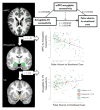Development of the emotional brain
- PMID: 29197573
- PMCID: PMC5984129
- DOI: 10.1016/j.neulet.2017.11.055
Development of the emotional brain
Abstract
In this article, we highlight the importance of dynamic reorganization of neural circuitry during adolescence, as it relates to the development of emotion reactivity and regulation. We offer a neurobiological account of hierarchical, circuit-based changes that coincide with emotional development during this time. Recent imaging studies suggest that the development of the emotional brain involves a cascade of changes in limbic and cognitive control circuitry. These changes are particularly pronounced during adolescence, when the demand for self regulation across a variety of emotional and social situations may be greatest. We propose that hierarchical changes in circuitry, from subcortico-subcortical to subcortico-cortical to cortico-subcortical and finally to cortico-cortical, may underlie the gradual changes in emotion reactivity and regulation throughout adolescence into young adulthood, with changes at each level being necessary for the instantiation of changes at the next level.
Keywords: Adolescence; Development; Emotion; Limbic; Prefrontal cortex.
Copyright © 2017 Elsevier B.V. All rights reserved.
Figures


References
-
- Luna B, Wright C. Adolescent brain development: Implications for the juvenile criminal justice system. APA Handb Psychol Juv Justice. 2016:91–116. doi: 10.1037/14643-005. - DOI
Publication types
MeSH terms
Grants and funding
LinkOut - more resources
Full Text Sources
Other Literature Sources

